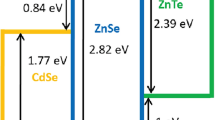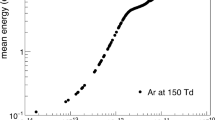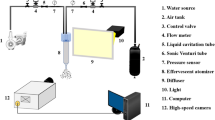Abstract
If a Li-ion cell fails and the electrolyte leaks out into air, a flammable premixed gas cloud can be formed. The electrolyte combustion energy is 65–70% of the total energy content of the cell. The main objective of this study is to determine the laminar burning velocity and the Markstein length for dimethyl carbonate and propane in a 20-liter explosion sphere with initial conditions at 100 kPa and 300 K. Five different stretch extrapolation models for the laminar burning velocity give practically the same result. The experimental results agree well with the previously published data and are slightly lower than the theoretical predictions. The laminar burning velocity for dimethyl carbonate is measured close to the saturation point under the initial conditions, which has not been previously reported.






Similar content being viewed by others
REFERENCES
N.-S. Choi, Z. Chen, S. A. Freunberger, et al., “Challenges Facing Lithium Batteries and Electrical Double-Layer Capacitors," Angew. Chem. Int. Ed. 51, 9994–10024 (2012); DOI: 10.1002/anie.201201429.
What’s the Best Battery? (Battery Univ., 2017); http://batteryuniversity.com/learn/archive/whats_the _best_battery.
D. Lisbona and T. Snee, “A Review of Hazards Associated with Primary Lithium and Lithium-Ion Batteries," Process Saf. Environ. Prot. 89 (6), 434–442 (2011); DOI: 10.1016/j.psep.2011.06.022.
P. G. Balakrishnan, R. Ramesh, and T. Prem Kumar, “Safety Mechanisms in Lithium-Ion Batteries," J. Power Sources155 (2), 401–414 (2006); DOI: 10.1016/j.jpowsour.2005.12.002.
S. Abada, G. Marlair, A. Lecocq, et al., “Safety Focused Modeling of Lithium-Ion Batteries: A Review," J. Power Sources306, 178–192 (2016); DOI: 10.1016/j.jpowsour.2015.11.100.
Q. Wang, P. Ping, X. Zhao, et al., “Thermal Runaway Caused Fire and Explosion of Lithium Ion Battery," J. Power Sources208, 210–224 (2012); DOI: 10.1016/j.jpowsour.2012.02.038.
C. Mikolajczak, M. Kahn, K. White, and R. T. Long,Lithium-Ion Batteries Hazard and Use Assessment, (Springer, Boston, 2011); DOI: 10.1007/978-1-4614-3486-3.
S. J. Harris, A. Timmons, and W. J. Pitz, “A Combustion Chemistry Analysis of Carbonate Solvents Used in Li-Ion Batteries," J. Power Sources 193 (2), 855–858 (2009); DOI: 10.1016/j.jpowsour.2009.04.030.
C. C. Crafts, D. H. Doughty, J. McBreen, and E. P. Roth, “Advanced Technology Development Program for Lithium-Ion Batteries: Thermal Abuse Performance of 18650 Li-Ion Cells," Sandia Report No. 2004-1584 (Sandia Nat. Lab., 2004); DOI: 10.2172/918751.
P. Ribière, S. Grugeon, M. Morcrette, et al., “Investigation on the Fire-Induced Hazards of Li-Ion Battery Cells by Fire Calorimetry," Energy Envir. Sci. 5, 5271–5280 (2012); DOI: 10.1039/C1EE02218K.
A. W. Golubkov, S. Scheikl, R. Planteu, et al., “Thermal Runaway of Commercial 18650 Li-Ion Batteries with LFP and NCA Cathodes—Impact of State of Charge and Overcharge," RSC Advances 5, 57171–57186 (2015); DOI: 10.1039/C5RA05897J.
F. Colella et al., “Analysis of Combustion Hazards due to Catastrophic Failures in Lithium-Ion Battery Packs," inProc. of the 7th Int. Seminar Fire and Explosion Hazards (Research Publ. Services, 2013), pp. 575–584; DOI: 10.3850/978-981-07-5936-0_09-02.
J. Johnsplass, Lithium-Ion Battery Safety (Univ. of South-Eastern Norway, 2017).
M. Henriksen, K. Vaagsaether, J. Lundberg, et al., “Explosion Characteristics for Li-Ion Battery Electrolytes at Elevated Temperatures," J. Hazard. Mater. 371, 1–7 (2019); DOI: 10.1016/j.jhazmat.2019.02.108.
D. Bjerketvedt, J. R. Bakke, and K. Van Wingerden, “Gas Explosion Handbook," J. Hazard. Mater. 52 (1), 1–150 (1997).
Z. Chen, “On the Accuracy of Laminar Flame Speeds Measured from Outwardly Propagating Spherical Flames: Methane/Air at Normal Temperature and Pressure," Combust. Flame 162 (6), 2442–2453 (2015); DOI: 10.1016/j.combustflame.2015.02.012.
J. Huo, S. Yang, Z. Ren, et al., “Uncertainty Reduction in Laminar Flame Speed Extrapolation for Expanding Spherical Flames," Combust. Flame 189, 155–162 (2018); DOI: 10.1016/j.combustflame.2017.10.032.
Ö. L. Gülder, “Correlations of Laminar Combustion Data for Alternative S. I. Engine Fuels," SAE Tech. Paper No. 841000, (1984); DOI: 10.4271/841000.
M. E. Bardin et al., “Laminar Burning Velocities of Dimethyl Carbonate with Air," Energy Fuels 27 (9), 5513–5517 (2013); DOI: 10.1021/ef401108a.
S. De Persis, N. Chaumeix, Y. Fernandes, et al., “Experimental and Theoretical Determination of DMC/Air Flame Velocities," in11th Int. Conf. on Chemical Kinetics, Orleans, 2019, Poster No. 30.
A. A. Konnov, A. Mohammad, V. R. Kishore, et al., “A Comprehensive Review of Measurements and Data Analysis of Laminar Burning Velocities for Various Fuel + Air Mixtures," Prog. Energy Combust. Sci.68, 197–267 (2018); DOI: 10.1016/j.pecs.2018.05.003.
L.-K. Tseng, M. A. Ismail, and G. M. Faeth, “Laminar Burning Velocities and Markstein Numbers of Hydrocarbon–Air Flames," Combust. Flame 95 (4), 410–426 (1993); DOI: 10.1016/0010-2180(93)90007-P.
G. Jomaas, X. L. Zheng, D. L. Zhu, and C. K. Law, “Experimental Determination of Counterflow Ignition Temperatures and Laminar Flame Speeds of C2–C3 Hydrocarbons at Atmospheric and Elevated Pressures," Proc. Combust. Inst. 30 (1), 193–200 (2005); DOI: 10.1016/j.proci.2004.08.228.
C. Tang, J. Zheng, Z. Huang, and J. Wang, “Study on Nitrogen Diluted Propane–Air Premixed Flames at Elevated Pressures and Temperatures," Energy Convers. Manage 51, 288–295 (2010); DOI: 10.1016/j.enconman.2009.09.024.
W. Lowry, J. de Vries, M. Krejci, et al., “Laminar Flame Speed Measurements and Modeling of Pure Alkanes and Alkane Blends at Elevated Pressures," J. Eng. Gas Turbines Power 133(9), ID 091501 (2011); DOI: 10.1115/1.4002809.
Q. Liu, Y. Zhang, F. Niu, and L. Li, “Study on the Flame Propagation and Gas Explosion in Propane/Air Mixtures," Fuel140, 677–684 (2015); DOI: 10.1016/j.fuel.2014.09.123.
M. Henriksen, K. Vaagsaether, A. V. Gaathaug, et al., “Laminar Burning Velocity Measurements for an Outwardly Propagating Flame of Dimethyl Carbonate and Air Mixtures," in Proc. of the 9th Int. Seminar on Fire and Explosion Hazards, St Petersburg, Russia, 2019 (Peter the Great St. Petersburg Polytech. Univ. Press, 2019), Vol. 1, pp. 161–172; DOI: 10.18720/spbpu/2/k19-29.
G. S. Settles, Schlieren and Shadowgraph Techniques: Visualizing Phenomena in Transparent Media (Springer, Berlin–New York, 2001).
F. Wu, W. Liang, Z. Chen, et al., “Uncertainty in Stretch Extrapolation of Laminar Flame Speed from Expanding Spherical Flames," Proc. Combust. Inst. 35, 663–670 (2015); DOI: 10.1016/j.proci.2014.05.065.
C. K. Law, Combustion Physics (Cambridge Univ. Press, 2006).
F. A. Williams, Combustion Theory (Chapman and Hall/CRC, Boulder, 2018).
G. H. Markstein, Nonsteady Flame Propagation(Elsevier Sci., Burlington, 2014).
Z. Chen, “On the Extraction of Laminar Flame Speed and Markstein Length from Outwardly Propagating Spherical Flames," Combust. Flame 158, 291–300 (2011); DOI: 10.1016/j.combustflame.2010.09.001.
A. P. Kelley, J. K. Bechtold, and C. K. Law, “Premixed Flame Propagation in a Confining Vessel with Weak Pressure Rise," J. Fluid Mech. 691, 26–51 (2012); DOI: 10.1017/jfm.2011.439.
A. P. Kelley and C. K. Law, “Nonlinear Effects in the Extraction of Laminar Flame Speeds from Expanding Spherical Flames," Combust. Flame 156, 1844–1851 (2009); DOI: 10.1016/j.combustflame.2009.04.004.
Q. Liu, X. Chen, Y. Shen, and Y. Zhang, “Parameter Extraction from Spherically Expanding Flames Propagated in Hydrogen/Air Mixtures," Int. J. Hydrogen Energy 44 (2), 1227–1238 (2019); DOI: 10.1016/j.ijhydene.2018.11.004.
A. Savitzky and M. J. E. Golay, “Smoothing and Differentiation of Data by Simplified Least Squares Procedures," Anal. Chem.36 (8), 1627–1639 (1964); DOI: 10.1021/ac60214a047.
D. G. Goodwin, H. K. Moffat, and R. L. Speth, “Cantera: An Object-Oriented Software Toolkit for Chemical Kinetics, Thermodynamics, and Transport Processes. Version 2.3.0," (2017); DOI: 10.5281/zenodo.170284.
P. A. Glaude, W. J. Pitz, and M. J. Thomson, “Chemical Kinetic Modeling of Dimethyl Carbonate in an Opposed-Flow Diffusion Flame," Proc. Combust. Inst. 30 (1), 1111–1118 (2005); DOI: 10.1016/j.proci.2004.08.096.
W. Sun, B. Yang, N. Hansen, et al., “An Experimental and Kinetic Modeling Study on Dimethyl Carbonate (DMC) Pyrolysis and Combustion," Combust. Flame 164, 224–238 (2016); DOI: 10.1016/j.combustflame.2015.11.019.
G. P. Smith, D. M. Golden, M. Frenklach, et al., “GRI-Mech 3.0," http://www.me.berkeley.edu/gri_mech/.
F. N. Egolfopoulos et al., “Advances and Challenges in Laminar Flame Experiments and Implications for Combustion Chemistry," Prog. Energy Combust. Sci. 43, 36–67 (2014); DOI: 10.1016/j.pecs.2014.04.004.
P. D. Ronney and H. Y. Wachman, “Effect of Gravity on Laminar Premixed Gas Combustion. I: Flammability Limits and Burning Velocities, Combust. Flame 62 (2), 107–119 (1985); DOI: 10.1016/0010-2180(85)90139-7.
A. P. Kelley, G. Jomaas, and C. K. Law, “Critical Radius for Sustained Propagation of Spark-Ignited Spherical Flames," Combust. Flame 156 (5), 1006–1013 (2009); DOI: 10.1016/j.combustflame.2008.12.005.
M. I. Hassan, K. T. Aung, O. C. Kwon, and G. M. Faeth, “Properties of Laminar Premixed Hydrocarbon/Air Flames at Various Pressures," J. Propul. Power 14 (4), 479–488 (1998); DOI: 10.2514/2.5304.
V. Pokorný, V. Štejfa, M. Fulem, et al., “Vapor Pressures and Thermophysical Properties of Dimethyl Carbonate, Diethyl Carbonate, and Dipropyl Carbonate," J. Chem. Eng. Data 62 (10), 3206–3215 (2017); DOI: 10.1021/acs.jced.7b00295.
Author information
Authors and Affiliations
Corresponding author
Rights and permissions
About this article
Cite this article
Henriksen, M., Vaagseather, K., Gaathaug, A. et al. Laminar Burning Velocity of the Dimethyl Carbonate–Air Mixture Formed by the Li-Ion Electrolyte Solvent. Combust Explos Shock Waves 56, 383–393 (2020). https://doi.org/10.1134/S0010508220040024
Received:
Published:
Issue Date:
DOI: https://doi.org/10.1134/S0010508220040024




